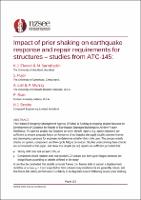| dc.contributor.author | Elwood, Ken | |
| dc.contributor.author | Pujol, Santiago | |
| dc.contributor.author | Liel, Abbie | |
| dc.contributor.author | Murray, Polly | |
| dc.contributor.author | Sarrafzadeh, Mehdi | |
| dc.contributor.author | Shah, Prateek | |
| dc.contributor.author | Brooke, Nicholas | |
| dc.date.accessioned | 2021-06-22T04:01:53Z | |
| dc.date.available | 2021-06-22T04:01:53Z | |
| dc.date.issued | 2021-04-14 | |
| dc.identifier.uri | https://repo.nzsee.org.nz/xmlui/handle/nzsee/2359 | |
| dc.description.abstract | ATC-145 is a FEMA funded project aimed at developing a Guide for repair of earthquake damaged buildings to achieve future resilience. Thanks in part to EQC funding, the project includes substantial New Zealand representation.
To date ATC-145 has focussed on whether minor repairs (i.e. epoxy injection and patch repair of spalling) are sufficient to ensure adequate future performance of earthquake-damaged ductile concrete moment frames. The framework considered necessary to answer this question comprises phases focussed on inspection, analysis, and assessments of impact on safety and serviceability.
Minor repairs for ductile concrete moment frames are deemed sufficient provided the damaging earthquake has not caused the structure to exceed various damage thresholds. Identifying the relevant thresholds, and the limiting values for each threshold, has formed a major part of the project work to date.
This paper will summarise the overall framework, with focus on studies undertaken to determine the relevant thresholds and limits for different parts of the safety and serviceability assessments. These studies principally comprise:
Collation of data from previous experiments to determine component deformation limits below which minor repair is sufficient, and the impacts of prior shaking on deformation demands in a future earthquake.
Analytical studies to determine structure drift limits below which minor repair is sufficient, and
Analytical studies to determine limits below which low cycle fatigue can be considered inconsequential.
These studies show that ductile concrete moment frames are generally robust, and that life safety performance is unlikely to be degraded except following severe prior shaking. | |
| dc.language.iso | en | |
| dc.publisher | New Zealand Society for Earthquake Engineering | |
| dc.relation.ispartofseries | 2021;0123 | |
| dc.subject | Resilience beyond life-safety and amenity | |
| dc.subject | Better building management in emergencies | |
| dc.subject | Advancements in structural and geotechnical design and assessment | |
| dc.title | ATC-145: Influence of prior shaking on earthquake response and repair requirements for structures and elements | |
| dc.type | Article | |

